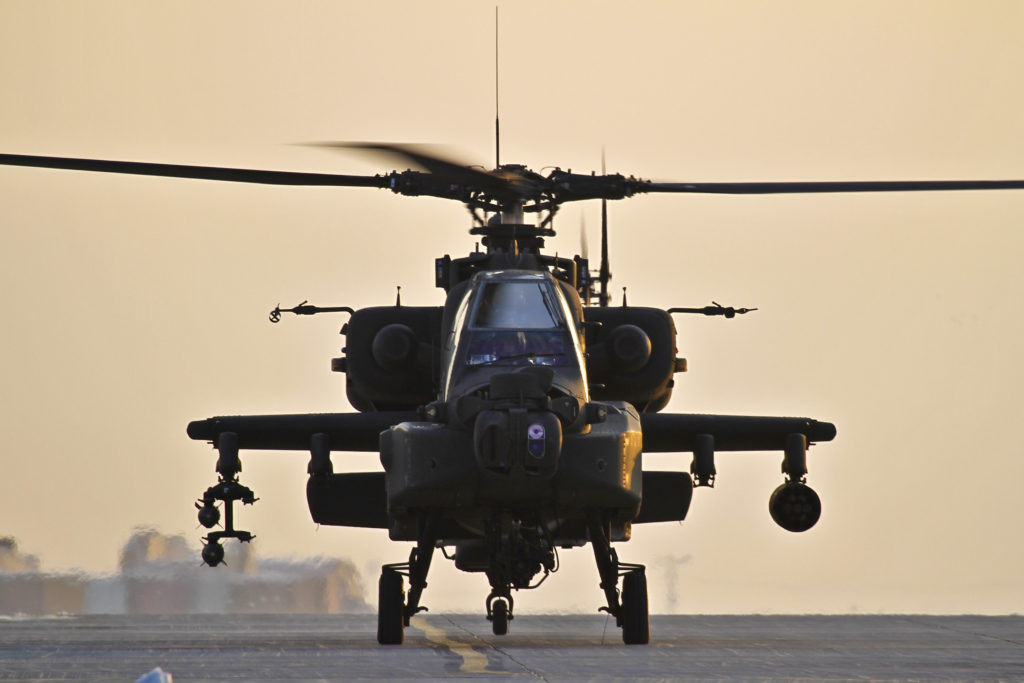

Objective
NVESD through MANTECH has matured a high dynamic range, Long Wave Infrared (LWIR) 3K X 3K Focal Plane Array (FPA). The Apache pilots desire a staring pilotage sensor in place of the current gimballed design to reduce latency and cockpit workload while increasing safety. This project would re-package the Integrated Detector Cooler Assembly (IDCA) to be more suitable for aircraft integration and stitch together three of the cameras to produce a seamless forward looking hemispherical image.
Description
Currently the AH-64E helicopter uses the Lockheed Martin Pilot Night Vision Sensor (PNVS) which is a mechanically gimbaled sensor that rotates and pivots. The IDCA is a second generation scanned 480 x 4 detector array which has the potential for becoming unsupported in the future.
The purpose of this topic is to repackage the IDCA and lens developed to support the LWIR 3Kx3K FPA into an integratable camera design. Stitch the camera imagery together to produce a staring sensor system. Conduct performance testing. Produce test reports. Deliver prototype miniaturized camera.
This large FPA and staring design configuration will increase sensor range as well as reduce the need for replacement or repair of the existing mechanically gimbaled PNVS system. The staring sensor configuration has no moving parts which will decrease any mechanical wear or breakage.
A staring approach will eliminate latency and provide 2 simultaneous video streams to each pilot which will increase safety.
Phase I
Integrate and design the 3Kx3K FPA into a miniaturized camera assembly. Deliver miniaturized Camera Design Documentation.
Phase II
Design interfaces and integrate the miniaturized camera on to an AH-64E Army helicopter. Design must fit into same volume as the existing LM PNVS system. The design shall be a staring, non-gimbaled configuration. Deliver integration and Interface Design Documentation.
Phase III
This technology has commercial helicopter and maritime applications, enabling pilots and unmanned systems to see in dark and adverse weather conditions
For the actual submission dates and to submit your full proposal package, visit the DSIP Portal.
Objective
NVESD through MANTECH has matured a high dynamic range, Long Wave Infrared (LWIR) 3K X 3K Focal Plane Array (FPA). The Apache pilots desire a staring pilotage sensor in place of the current gimballed design to reduce latency and cockpit workload while increasing safety. This project would re-package the Integrated Detector Cooler Assembly (IDCA) to be more suitable for aircraft integration and stitch together three of the cameras to produce a seamless forward looking hemispherical image.
Description
Currently the AH-64E helicopter uses the Lockheed Martin Pilot Night Vision Sensor (PNVS) which is a mechanically gimbaled sensor that rotates and pivots. The IDCA is a second generation scanned 480 x 4 detector array which has the potential for becoming unsupported in the future.
The purpose of this topic is to repackage the IDCA and lens developed to support the LWIR 3Kx3K FPA into an integratable camera design. Stitch the camera imagery together to produce a staring sensor system. Conduct performance testing. Produce test reports. Deliver prototype miniaturized camera.
This large FPA and staring design configuration will increase sensor range as well as reduce the need for replacement or repair of the existing mechanically gimbaled PNVS system. The staring sensor configuration has no moving parts which will decrease any mechanical wear or breakage.
A staring approach will eliminate latency and provide 2 simultaneous video streams to each pilot which will increase safety.
Phase I
Integrate and design the 3Kx3K FPA into a miniaturized camera assembly. Deliver miniaturized Camera Design Documentation.
Phase II
Design interfaces and integrate the miniaturized camera on to an AH-64E Army helicopter. Design must fit into same volume as the existing LM PNVS system. The design shall be a staring, non-gimbaled configuration. Deliver integration and Interface Design Documentation.
Phase III
This technology has commercial helicopter and maritime applications, enabling pilots and unmanned systems to see in dark and adverse weather conditions
For the actual submission dates and to submit your full proposal package, visit the DSIP Portal.
